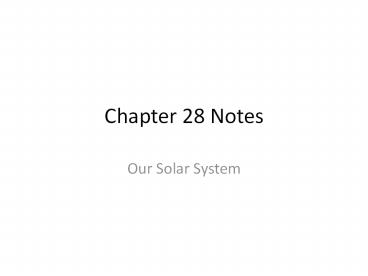Chapter%2028%20Notes - PowerPoint PPT Presentation
Title:
Chapter%2028%20Notes
Description:
Chapter 28 Notes Our Solar System Our Solar System The Inner Planets (and Pluto) All the Planets (and Pluto) The Planets and the Sun (and Pluto) Formation of the ... – PowerPoint PPT presentation
Number of Views:160
Avg rating:3.0/5.0
Title: Chapter%2028%20Notes
1
Chapter 28 Notes
- Our Solar System
2
Our Solar System
3
The Inner Planets (and Pluto)
4
All the Planets (and Pluto)
5
The Planets and the Sun (and Pluto)
6
Formation of the Solar System
- Nebular Theory
- Interstellar cloud contracts and spins
- Dense center begins nuclear fusion (sun)
- Remaining material forms planetesimals and then
planets
7
Historical Solar System Models
- Geocentric (Earth-centered) model
- One problem was how to explain retrograde motion
- Copernicus heliocentric model
- 1543, Polish scientist
- Planets (including Earth) orbit the Sun in
circular orbits - Supporting evidence collected by Tycho Brahe
8
Keplers laws of planetary motion
- Johannes Kepler inherited Tychos data after his
unexpected death.
9
Galileo
- First person to use a telescope to observe the
sky - Discovered moons orbiting Jupiter
- Also observed sun spots, phases of Venus, and
Moon craters
10
Newton and Gravity
- Newtons discovery of the law of universal
gravitation provided an explanation for the
heliocentric model of the solar system
11
Zone 1 Inner Planets
- Terrestrial Earth-like
- Small
- Composed of rock (high density)
- Close to the Sun
- Few or no moons
- No rings
12
Mercury
- Smallest
- Closest to the Sun
- No moons
- No atmosphere
- Cratered like the Moon
- 1 orbit 1.5 rotations (2 years 3 days)
13
Venus
- No moons
- Earths twin in size
- Rotates backwards
- 1 day 243 Earth days
- Very high CO2 concentration in the atmosphere
causes super greenhouse effect - Surface temperature of 464?C!!
- Can be seen as a bright morning or evening star
14
Earth
- One moon
- Tectonically active
- O2 in atmosphere
- Water exists in all 3 phases
- Mild greenhouse effect to keep the planet warm
enough for life
15
Mars
- The red planet
- CO2 atmosphere
- 2 moons (Phobos and Deimos)
- Has seasons like Earth, but a year is twice as
long - Largest volcano in the solar system Olympus Mons
- Once had liquid water, has polar CO2 ice caps
16
Outer Planets
- Gas giants or Jovian Jupiter-like
- Large
- Low density
- Lots of moons
- All have ring systems
- Far from the Sun
17
Jupiter
- Largest planet
- Banded appearance
- Great red spot
- Faint ring system
- 4 large moons, more than 60 total
- Rapid rotation (10 hours 1 day) shortest day
of all the planets
18
Saturn
- Famous for ring system
- More than 55 moons
- Density lower than water
- Largest moon, Titan, has an atmosphere of
nitrogen and methane - Another moon, Enceladus, shows evidence of
geologic activity
19
Uranus
- Discovered in 1781
- Rotational axis is 98?
- At least 27 moons
- Rings are dark and nearly invisible
- Appears blue because of the way it reflects light
20
Neptune
- Discovered 1846
- 13 moons
- Distinctive clouds and belts
- Predicted before it was discovered
- 6 rings composed of dust particles
- Largest moon, Triton, orbits backwards
21
Other Solar System Objects
- Dwarf planets
- Asteroids
- Kuiper belt objects (KBOs)
- Comets (the Oort cloud)






























